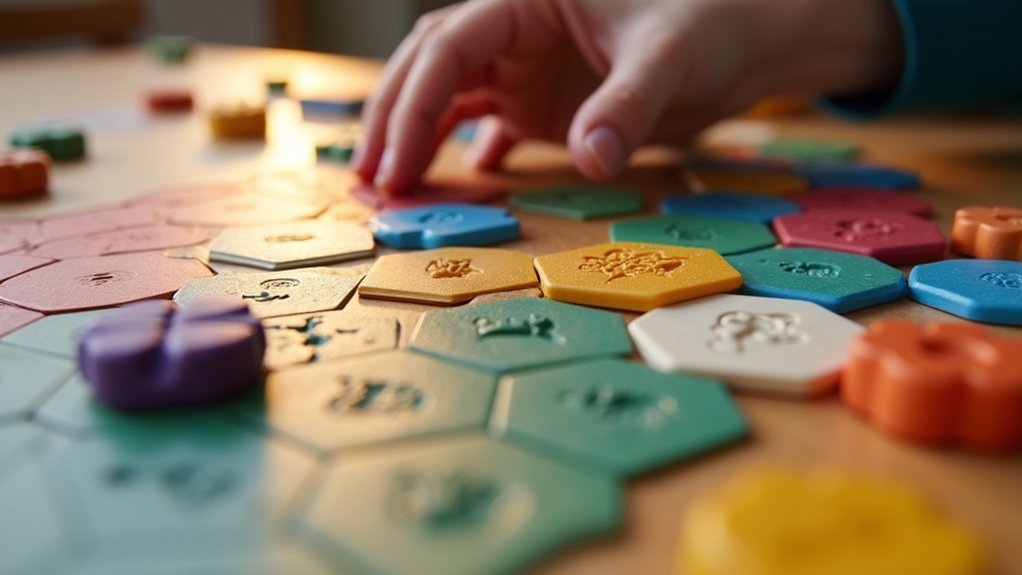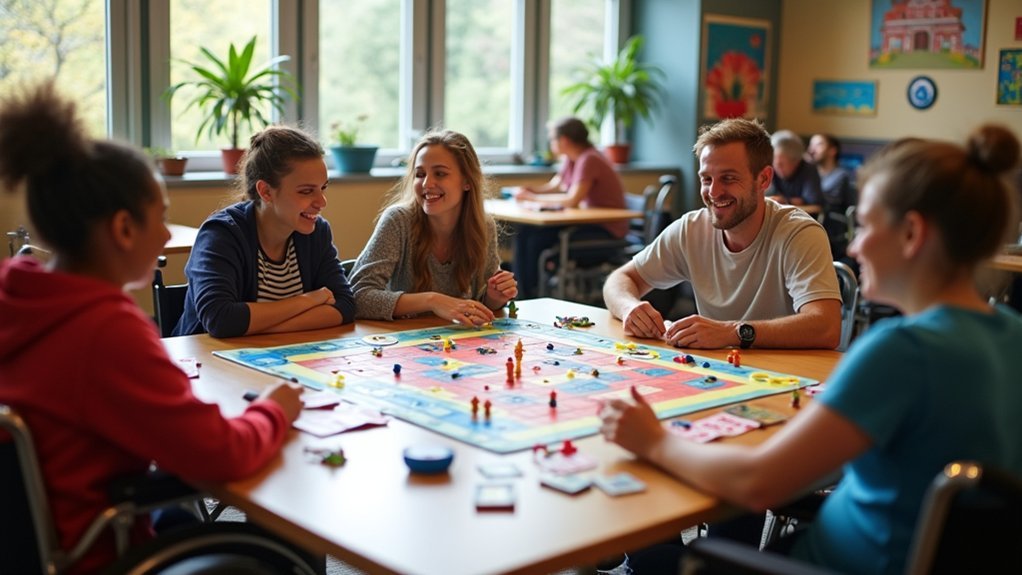Modified board games leverage tactile elements, digital tools, and cognitive adaptations to create inclusive experiences for players with different abilities. You’ll find options like raised symbols for visually impaired players, AR enhancements for gameplay support, and simplified rule structures for cognitive accessibility. Sensory-friendly modifications with color-coding and texture variations help accommodate various needs, while companies like MarvelSoft offer specially designed accessible games. The world of accessible gaming opens doors to connection and enjoyment for everyone at the table.
Tactile Adaptations for Visually Impaired Players

How can visually impaired players fully participate in the strategic fun of board games? The answer lies in thoughtful tactile adaptations.
Using raised point symbols shaped for comfortable fingertip recognition, you can transform standard game components into accessible ones. Assign consistent symbols to different colors—perhaps an open circle for green, V-shape for orange, bump for blue, and X-shape for yellow.
Tactile symbols unlock colorful worlds, turning everyday board games into accessible experiences through fingertip-readable patterns.
Apply unique textures to game elements using materials like APH Feel n’ Peel Stickers or Carousel of Textures sheets. Soft textures might represent blue while rough surfaces indicate red. Companies like MarvelSoft Enterprises offer specially designed tactile games including Chess, Checkers, and Scrabble for visually impaired users.
For number-based games, add braille stickers to dice and cards.
Popular games like Checkers, Connect 4, and Cribbage adapt well with these modifications, allowing blind and sighted players to enjoy games together without requiring specially designed variants.
Digital Solutions for Enhanced Accessibility in Tabletop Games
You’ll find digital solutions transforming traditional board games through screen reader compatibility that announces game states and available moves audibly for visually impaired players.
AR enhancements can highlight game pieces and potential moves through your smartphone or tablet, making complex games more approachable for players with cognitive challenges.
These technological adaptations don’t replace the tactile experience of board games but instead complement them by removing barriers that might otherwise prevent full participation. The increasing digitization trend has enabled more inclusive gaming experiences by bridging accessibility gaps while maintaining the social benefits that traditional board games offer.
Screen Readers Integration
While traditional board games rely heavily on visual elements, integrating screen reader technology represents a significant advancement in making tabletop gaming accessible to players with visual impairments.
You’ll find that digital adaptations of board games make this integration more seamless, allowing for text-to-speech functionality and audio cues that describe game states.
- Voice assistants like Alexa can read rulebooks and provide real-time guidance during gameplay.
- Digital companion apps offer screen reader compatibility for traditional physical games.
- Game developers are increasingly building screen reader support directly into digital versions of tabletop games.
- User feedback from visually impaired players continues to drive improvements in how screen readers interpret game information.
Collecting player input helps refine these technologies, ensuring they’re genuinely useful rather than merely present. The implementation of screen readers in tabletop gaming reflects the broader movement toward inclusive video games that promote equality and representation in gaming communities.
AR Gameplay Enhancements
Augmented Reality (AR) technology has revolutionized tabletop gaming by creating digital overlays that enhance traditional board games for players with diverse abilities. Through Spatial Augmented Reality and GameARt methods, you’ll experience interactive visuals that transform physical spaces into immersive gaming environments.
AR offers accessibility features including voice commands, text-to-speech functions, and alternative control methods that accommodate mobility impairments. Platforms like Mirrorscape are specifically designed to be user-friendly platforms that reduce physical and cognitive busywork for differently abled demographics. You can enjoy virtual game boards that require less physical space while participating in remote play from anywhere.
The technology adapts to your specific needs through customizable interfaces and adaptive algorithms that balance gameplay difficulty. As developers collect user interaction data and feedback, AR implementations continue to improve, making tabletop games increasingly accessible across diverse demographics and abilities.
Designing Board Games With Cognitive Considerations

When designing board games with cognitive considerations, you’ll want to implement adjustable game speed options that allow players to progress at their own pace.
Visual processing adaptations, including high-contrast components and intuitive iconography, can greatly reduce cognitive barriers for players with processing differences.
Memory-friendly game design features, such as reference cards and minimal memorization requirements, guarantee everyone can participate without feeling overwhelmed by complex rules or game states. Consider incorporating simple game versions with layered complexity that can grow with player comfort and familiarity.
Adjustable Game Speed
Four key principles drive the design of adjustable game speed in board games, creating more inclusive and engaging experiences for players with varying cognitive abilities.
When you implement variable pacing mechanisms, you’re providing players control over their experience while maintaining the game’s core appeal.
Adjustable speed features benefit players across cognitive spectrums by:
- Reducing frustration through customizable rule options that match individual processing speeds
- Enhancing engagement with dynamic difficulty adjustments that respond to player performance
- Supporting learning and development by allowing players to progress at their own pace
- Creating inclusive environments where different cognitive abilities can play together comfortably
These modifications don’t compromise gameplay integrity but rather enhance accessibility. Emphasizing significant state changes between turns keeps players engaged while accommodating different processing speeds.
Consider incorporating action point systems, modular components, or variable difficulty levels to create board games that respect diverse cognitive needs.
Visual Processing Adaptations
Designing board games with visual processing adaptations requires thoughtful consideration of both cognitive and physical accessibility needs.
You’ll want to incorporate tactile elements that allow visually impaired players to engage through touch, effectively converting visual information into accessible formats.
Consider implementing components that enhance visuospatial processing skills, which benefit all players while supporting those with visual processing challenges.
Games that promote holistic mental rotation strategies can improve spatial reasoning abilities. Research shows spatial play activities differ significantly in their effectiveness for developing cognitive skills, with structured block play outperforming traditional board games. Structured elements similar to block play can further develop these cognitive skills.
When adapting traditional games, focus on creating environments that players can navigate through multiple sensory channels.
Spatial Augmented Reality (SAR) offers promising solutions for enhancing interactivity.
Remember that game complexity can be maintained while improving accessibility—inclusive design doesn’t mean simplifying the experience.
Memory-Friendly Game Design
Beyond visual accessibility, memory-friendly game design establishes another foundation for inclusive board games.
You’ll find these designs particularly beneficial for seniors and those with cognitive impairments, while still engaging players of all abilities.
When designing memory-supportive games, consider integrating these cognitive principles:
- Adaptive complexity – Create tiered rule systems that adjust to different cognitive levels while maintaining core gameplay.
- Multisensory cues – Incorporate visual, tactile, and auditory elements to strengthen memory encoding.
- Strategic scaffolding – Build in memory aids that can be gradually removed as players develop confidence.
- Progress tracking – Implement clear feedback mechanisms that celebrate cognitive improvements over time.
These adaptations transform traditional games into therapeutic tools that stimulate recall abilities while providing enjoyable social experiences that bridge cognitive differences. Research shows that games designed with these principles can significantly contribute to lowering dementia risk when played regularly by older adults.
The Role of AR Technology in Creating Inclusive Gaming Experiences

Augmented Reality (AR) has emerged as a transformative force in creating inclusive board gaming experiences for players with disabilities. You’ll find that AR platforms remove physical barriers by enabling remote gameplay, benefiting those with mobility impairments while maintaining social connections through virtual tabletops.
AR technology offers alternative control schemes that adapt to your abilities. Whether you prefer verbal commands, eye-tracking, or touchless gestures, these systems accommodate diverse physical capabilities. The intuitive interfaces reduce reliance on complex rulebooks and manual dexterity. Effective AR implementations embrace universal design principles to ensure games are accessible to users with various needs and preferences.
For players with cognitive or sensory impairments, AR provides real-time adaptive feedback, personalized challenges, and multimodal presentations. Games can adjust speed, contrast, and complexity based on your needs.
This technology democratizes board gaming, welcoming players who’ve been historically excluded from traditional tabletop experiences.
Modifying Game Rules for Players With Different Abilities
When customizing board games for diverse players, rule modifications serve as the foundation for truly inclusive gaming experiences.
You’ll find that thoughtful adjustments to game mechanics can dramatically improve accessibility without compromising core gameplay elements that make the experience enjoyable.
- Flexible Turn Structures – Implement variable turn timers or allow players to bank actions for later use, accommodating different processing speeds.
- Tiered Challenge Levels – Create rule variations that players can select based on their abilities, ensuring everyone faces appropriate challenges.
- Alternative Victory Conditions – Develop multiple paths to success that reward different types of skills and approaches.
- Collaborative Extensions – Add options for cooperative play within traditionally competitive games, fostering supportive interactions among players with varying abilities. Consider how exceptions to standard rules can create unique character abilities that make gameplay more accessible to players with different needs.
Building Community Through Accessible Gaming

Community gaming events offer you powerful opportunities to bridge differences through inclusive play experiences.
When you participate in accessible gaming meetups, you’ll connect with diverse players who share your passion while building meaningful relationships across ability levels. These events often follow the example of games like Celeste and The Last of Us 2, which include extensive accessibility features to ensure everyone can participate regardless of ability.
These shared gaming experiences create lasting bonds that extend beyond game night, fostering empathy and understanding throughout your broader community.
Community Gaming Events
The power of accessible gaming events lies in their ability to transform isolated experiences into vibrant community connections. When you organize inclusive gaming events, you’re creating spaces where over 90% of disabled gamers find meaningful relationships and combat chronic loneliness.
Partnerships between disability organizations and gaming companies make these specialized gatherings possible. The creation of these inclusive spaces for players emphasizes accessibility in gaming environments.
For truly accessible community events, consider:
- Ensuring wheelchair accessibility and appropriate lighting at venues
- Providing assistive technology and adapted gaming materials
- Training staff on disability awareness and inclusive facilitation
- Implementing flexible rules and adjustable game pacing
These adjustments create environments where everyone participates equally, regardless of ability.
Case studies show these events considerably improve mental health for attendees with complex disabilities by offering social opportunities otherwise unavailable to them.
Shared Inclusive Experiences
Creating genuinely inclusive gaming experiences bridges the gap between diverse players, forging connections that transcend physical and cognitive differences.
When you design or modify board games with accessibility in mind, you’re enabling shared experiences that build community among players of all abilities.
Research shows that 64% of gamers value diversity in gaming, while 91% of gamers with disabilities report their disability affects their gaming experience.
By implementing adaptive difficulty levels and intuitive interfaces, you’ll help the estimated 20-30% of gamers with disabilities fully participate.
Shared gaming experiences foster equality and inclusivity, allowing players to connect through gameplay rather than being defined by their abilities.
As technology advances, these opportunities will only grow, contributing to an inclusive gaming future for the nearly 3 billion gamers worldwide.
Diverse audiences, including the 47% of gamers who avoid games not meant for them, demonstrate a clear demand for more representative and accessible gaming experiences.
Equitable Play: Ensuring Fair Adaptations for All
While board games can bring people together, they often fail to accommodate players of all abilities, creating barriers to participation. When designing modifications, you’ll need to guarantee adaptations preserve the game’s core experience while providing equal opportunities for all players.
- Design with diversity in mind – Seek input from players with different abilities to identify potential barriers in gameplay mechanics. The gaming industry’s tendency to overlook diverse perspectives contributes significantly to accessibility challenges.
- Balance assistance with independence – Create adaptations that empower players rather than making them dependent on others.
- Standardize accessibility features – Develop consistent approaches to modifications that players can anticipate across different games.
- Incorporate digital elements – Use technology to enhance accessibility through audio cues, visual aids, or alternative input methods.
Sensory-Friendly Game Modifications

Because traditional board games often overwhelm players with sensory sensitivities, thoughtful modifications can transform gaming into an inclusive experience for everyone at the table.
Consider incorporating visual supports like picture cards, color-coding, and step-by-step guides to enhance understanding and engagement.
Create calming environments by dimming lights, reducing background noise, and offering fidget tools for self-regulation.
Adapt game components by adding textures to pieces, using card holders, or replacing small items with larger alternatives.
Don’t hesitate to modify rules—simplify instructions, shorten gameplay, or divide sessions into manageable chunks.
Provide clear, consistent structure while remaining flexible to individual needs. Introducing visual timers can significantly improve turn-taking support for children who struggle with waiting.
These accommodations maintain the fun while reducing sensory overload, ensuring everyone can participate comfortably in family game night.
Custom Game Components for Physical Accessibility Needs
Physical limitations should never prevent anyone from enjoying board games, which is why thoughtfully designed custom components can transform the gaming experience.
Gaming accessibility isn’t optional—it’s essential for building inclusive communities where everyone can share the joy of play.
You’ll find that ergonomic pieces, tactile markers, and adaptive tools can make gameplay possible for everyone at the table.
- Oversized, textured components allow players with limited dexterity or visual impairments to easily identify and manipulate game pieces.
- Card holders with wide, stable bases prevent fatigue during extended play sessions while keeping information visible.
- Magnetic game boards with grid references guarantee pieces stay in place and help players communicate locations clearly.
- Component organizers with color-coding and labels keep gameplay flowing smoothly without requiring fine motor skills for setup and storage.
Thoughtful design choices that avoid tight physical placement of game elements can significantly improve accessibility for players with mobility challenges.
The Impact of Representation in Modified Game Design
Beyond accessible components, representation in modified game design carries profound significance for players with diverse abilities. When you incorporate inclusive storylines and dynamic characters reflecting different abilities, you create emotional connections that keep players engaged and loyal.
You’ll find that games featuring realistic scenarios and diverse role models resonate more deeply with your audience, fostering empathy among all players. This representation isn’t just socially valuable—it opens market opportunities by attracting broader audiences. The survey from Meeples for Change revealed that approximately 22% of respondents reported difficulties playing games due to lack of accessibility.
Implementing adaptive difficulty settings and modification options guarantees everyone can participate meaningfully. Consider establishing community forums and player surveys to continuously refine your designs based on feedback.
The most successful modified games balance design challenges with cultural sensitivity, creating experiences where players see themselves reflected in gameplay, themes, and stories.
Frequently Asked Questions
How Expensive Are Accessibility Modifications Compared to Standard Game Versions?
Accessibility modifications can cost you ten times more than standard games. You’ll find official Braille versions like Monopoly around $80. You can save money by creating your own DIY adaptations instead of buying retail.
Can Mainstream Publishers Retrofit Existing Popular Games With Accessibility Features?
Yes, you’ll find publishers can retrofit popular games with accessibility features like high-contrast cards, larger text, tactile elements, and digital companions. However, they’ll face design constraints and production cost considerations when modifying existing titles.
What Training Do Game Designers Receive About Accessibility Needs?
Designers typically access formal training through Microsoft Learn, Unity courses, and platforms like Udemy. You’ll find they’re taught inclusive design principles, customizable controls, and visual/audio accommodations. Many studios now consider accessibility knowledge a fundamental skill.
How Do Accessibility Modifications Affect Gameplay Time and Complexity?
You’ll find accessibility modifications can both increase and decrease gameplay time. They often reduce complexity through simplified rules and clearer visuals, making games more navigable for players with different abilities.
Are There Certification Standards for Accessible Board Game Design?
No, there aren’t specific certification standards for accessible board game design. You’ll find safety certifications from CPSC and ASTM F963, but accessibility innovations are primarily driven by consumer demand rather than formal regulations.
In Summary
You’ve explored how board games can transform to welcome everyone at the table. Whether through tactile elements, digital aids, or simplified rules, you’re now equipped to modify games for different abilities. Remember, it’s not about changing the core experience—it’s about removing barriers so everyone can enjoy the same fun, connection, and challenge that makes gaming special in the first place.





Leave a Reply